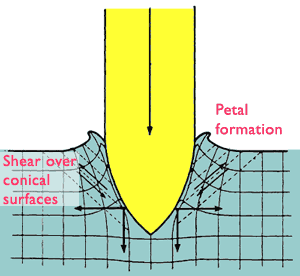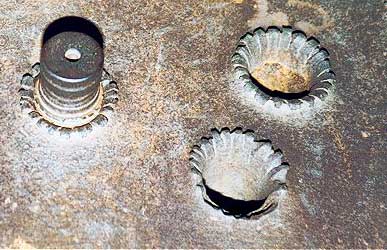
Logo from Scott Cunningham.

Logo from Scott Cunningham.
 onsider a projectile fired at normal against the face of a semi-infinite mass of armour, i.e., armour plate so thick that the rear face has no influence over the processes occurring on the front face. As the head forces its way into the plate, any element of the head surface in contact with the plate exerts a compressive force on the plate. Metallurgical examination of damaged plates shows a thin surface layer of plate either melts or is raised to such a high temperature that the coefficient of friction between the plate and projectile is likely to be low. Thus the compressive force of the head is roughly normal to the head surface at any part, and may be resolved into axial and equally distributed radial components.1
onsider a projectile fired at normal against the face of a semi-infinite mass of armour, i.e., armour plate so thick that the rear face has no influence over the processes occurring on the front face. As the head forces its way into the plate, any element of the head surface in contact with the plate exerts a compressive force on the plate. Metallurgical examination of damaged plates shows a thin surface layer of plate either melts or is raised to such a high temperature that the coefficient of friction between the plate and projectile is likely to be low. Thus the compressive force of the head is roughly normal to the head surface at any part, and may be resolved into axial and equally distributed radial components.1

Mode of deformation associated with the formation of front petals. Diagram from 1.
As a result of the radial load, the plate material shears over a series of co-axial conical surfaces, cutting the plate face at approximately 45°. The shear stress is greatest over the surface closest to the ogive. Plastic displacement occurs there first and then extends to surfaces further out as work hardening occurs, and as the projectile penetrates to greater depth. Due to the form of the ogive, and as a result of the radial velocity imparted to the plate material displaced by it, a raised collar builds up around the head. This tends to split into petals under the influence of tensile stresses. If, however, the plate has rather less ductility and is incapable of so much deformation in shear, shear fracture will occur over one of the conical surfaces, breaking off the petals.1

An example of front petal formation caused by 75mm AP attack. Notice that the petals on the bottom half of the lower crater have sheared off. From the private collection of Chris Shillito.
As penetration proceeds, displacement of the plate by the process described above obviously becomes more difficult, since there is a rapid increase in the area over which shear must occur if displacement is to extend to the plate surface. Examination of impressions in thick plates suggests that the process of front petal deformation has virtually ceased by the time the ogive is completely immersed in the plate.1
 Formation of a Bulge on the Back Face
Formation of a Bulge on the Back Face
Do you like this web site? Please rate it between one and ten, with ten being the best:
Ratings are submitted to: The Wargames and Military History Search Engine.
Copyright © 2000 David Michael Honner. E-mail: GvA@wargamer.org.